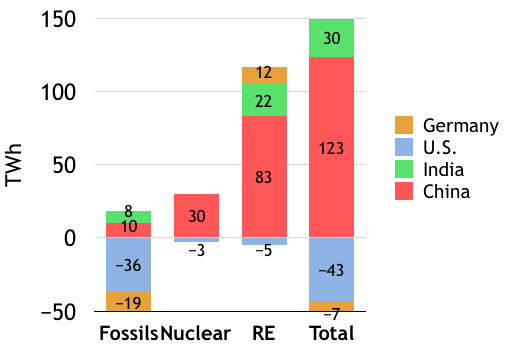The development of energy supply during the first half of 2019 gives hope that unmanageable climate change can be avoided. Fossil electricity generation is declining overall in four large countries, and renewable electricity increases significantly in three of the four countries.
Change in Electricity Generation by Technology
Germany, the U.S., India and China H1 2019-2018
In the US, the decline in coal power was dramatic. 72 TWh less coal power than the first half of the year 2018. This was the result of many coal power plants being closed last year and the demand for electricity decreasing in the US. Electricity production with gas increased, but not enough to compensate the loss in coal, so total fossil electricity production decreased by 36 TWh. Solar and wind electricity increased, while hydropower decreased more due to less rainfall.
Despite the decline in hydropower, renewable energy generated more electricity during the second quarter than coal power in the US. It was the first time that happened in a full quarter.
In China, total electricity consumption and all forms of electricity generation increased. The smallest increase was fossil electricity generation, 10 TWh. Nuclear power increased 3 times as much and renewable more than 8 times as much, by 83 TWh.
India's electricity consumption also increased. Fossil electricity generation accounted for only 27% of the increase. Renewable electricity accounted for the rest and also compensated for the small decline in nuclear power.
In Germany, fossil electricity generation decreased by 19 TWh and renewable energy generated 12 TWh more than in the first half of 2018. Total electricity generation as well as nuclear power decreased slightly. With the breakdown of Fraunhofer's statistics, wind power was Germany's largest source of energy for electricity generation throughout the first half of the year, followed by lignite, nuclear power and hard coal.
In June, solar energy was the largest source of electricity followed by lignite and wind power. It was the first full month solar was the largest source.
Renewable energy generated more electricity than fossil fuels and accounted for almost half of the net electricity generation in Germany. In 2000, renewable energy produced less than 10 percent.
Donald Trump's trade war has slowed the rate of economic development in the world, and thus the consumption of fossil fuels. In the United States, the economy has developed slowly and demand for electricity has even diminished.
Asian development has often been described as fossil-dependent and technologically primitive. This may have been a relevant description. China and India both still have a greater share of fossil electricity generation than the rest of the world. But that is changing: China passed the world average in 2014 and now has a larger share of renewable electricity than the approximately 25% in the rest of the world has.
In two years, India has increased its share of renewable electricity from 15 to 17%. In TWh, this means that renewable electricity increased by 53 TWh, which is more than all nuclear power plants in India produce. Also in China, renewable electricity generation in two years has grown more than the total nuclear power produced in 2018.
India is about to catch up with the rest of the world in the share of renewable energy, China is slightly above and Germany has almost twice the share of renewable electricity as the rest of the world.
The US and Germany have a greater share of nuclear power than the rest of the world. Globally, the share has dropped to 10%. In the US, Germany and India the proportion is also declining, while it has increased in China, though still on a low level.
In China, however, no reactor construction has begun since December 2016 according to the IAEA, and in India none since October 2017. Therefore, it is now crucial for the development of fossil fuels in the next few years that the expansion of renewable electricity in the future goes faster than the increase in demand.
The first half year electricity data of these major countries looks promising. The combination of Donald Trump's trade war and the rapid development of renewable electricity generation means that there is hope that carbon dioxide emissions from fossil fuels will not only increase less than 2018, they may even decrease in 2019!







